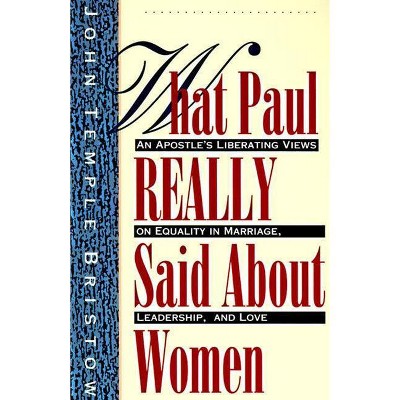$24.38 sale price when purchased online
$29.95 list price
Target Online store #3991
About this item
Highlights
- A groundbreaking new account of the writing of the Hebrew Bible Who wrote the Bible?
- About the Author: William M. Schniedewind is professor of biblical studies and the Sady and Ludwig Kahn Director of the Alan D. Leve Center for Jewish Studies at the University of California, Los Angeles, where he was the inaugural holder of the Kershaw Chair of Ancient Eastern Mediterranean Studies.
- 360 Pages
- Religion + Beliefs, Biblical Studies
Description
About the Book
Schniedewind draws on ancient inscriptions, archaeology, and anthropology, as well as a close reading of the biblical text itself, to trace the communal origin of biblical literature. Scribes were educated through apprenticeship rather than in schools. The prophet Isaiah, for example, has his "disciples"; Elisha has his "apprentice." This mode of learning emphasized the need to pass along the traditions of a community of practice rather than to individuate and invent. Schniedewind shows that it is anachronistic to impose our ideas about individual authorship and authors on the writing of the Bible. Ancient Israelites didn't live in books, he writes, but along dusty highways and byways. Who Really Wrote the Bible describes how scribes and their apprentices actually worked in ancient Jerusalem and Judah.Book Synopsis
A groundbreaking new account of the writing of the Hebrew Bible
Who wrote the Bible? Its books have no bylines. Tradition long identified Moses as the author of the Pentateuch, with Ezra as editor. Ancient readers also suggested that David wrote the psalms and Solomon wrote Proverbs and Qohelet. Although the Hebrew Bible rarely speaks of its authors, people have been fascinated by the question of its authorship since ancient times. In Who Really Wrote the Bible, William Schniedewind offers a bold new answer: the Bible was not written by a single author, or by a series of single authors, but by communities of scribes. The Bible does not name its authors because authorship itself was an idea enshrined in a later era by the ancient Greeks. In the pre-Hellenistic world of ancient Near Eastern literature, books were produced, preserved, and passed on by scribal communities. Schniedewind draws on ancient inscriptions, archaeology, and anthropology, as well as a close reading of the biblical text itself, to trace the communal origin of biblical literature. Scribes were educated through apprenticeship rather than in schools. The prophet Isaiah, for example, has his "disciples"; Elisha has his "apprentice." This mode of learning emphasized the need to pass along the traditions of a community of practice rather than to individuate and invent. Schniedewind shows that it is anachronistic to impose our ideas about individual authorship and authors on the writing of the Bible. Ancient Israelites didn't live in books, he writes, but along dusty highways and byways. Who Really Wrote the Bible describes how scribes and their apprentices actually worked in ancient Jerusalem and Judah.Review Quotes
"An important corrective to the tendency to impose contemporary notions of lone authorship onto these ancient texts."-- "Choice"
"An important work in academic biblical studies."---David Tesler, AJL Reviews
"[An] illuminating book."-- "Library Journal"
"Insightful and enjoyable. . . . Schniedewind's erudite but still conversational prose brings admirable clarity to ancient breadcrumb trails of evidence. It's an enlightening deep dive into the social world in which the Bible was written."-- "Publishers Weekly"
About the Author
William M. Schniedewind is professor of biblical studies and the Sady and Ludwig Kahn Director of the Alan D. Leve Center for Jewish Studies at the University of California, Los Angeles, where he was the inaugural holder of the Kershaw Chair of Ancient Eastern Mediterranean Studies. He is the author of How the Bible Became a Book, A Social History of Hebrew: Its Origins Through the Rabbinic Period, The Finger of the Scribe: How Scribes Learned to Write the Bible, and other books.Dimensions (Overall): 9.4 Inches (H) x 6.2 Inches (W) x 1.3 Inches (D)
Weight: 1.75 Pounds
Suggested Age: 22 Years and Up
Number of Pages: 360
Genre: Religion + Beliefs
Sub-Genre: Biblical Studies
Publisher: Princeton University Press
Theme: Exegesis & Hermeneutics
Format: Hardcover
Author: William M Schniedewind
Language: English
Street Date: June 18, 2024
TCIN: 90076243
UPC: 9780691233178
Item Number (DPCI): 247-25-4515
Origin: Made in the USA or Imported
If the item details above aren’t accurate or complete, we want to know about it.
Shipping details
Estimated ship dimensions: 1.3 inches length x 6.2 inches width x 9.4 inches height
Estimated ship weight: 1.75 pounds
We regret that this item cannot be shipped to PO Boxes.
This item cannot be shipped to the following locations: American Samoa (see also separate entry under AS), Guam (see also separate entry under GU), Northern Mariana Islands, Puerto Rico (see also separate entry under PR), United States Minor Outlying Islands, Virgin Islands, U.S., APO/FPO
Return details
This item can be returned to any Target store or Target.com.
This item must be returned within 90 days of the date it was purchased in store, shipped, delivered by a Shipt shopper, or made ready for pickup.
See the return policy for complete information.












